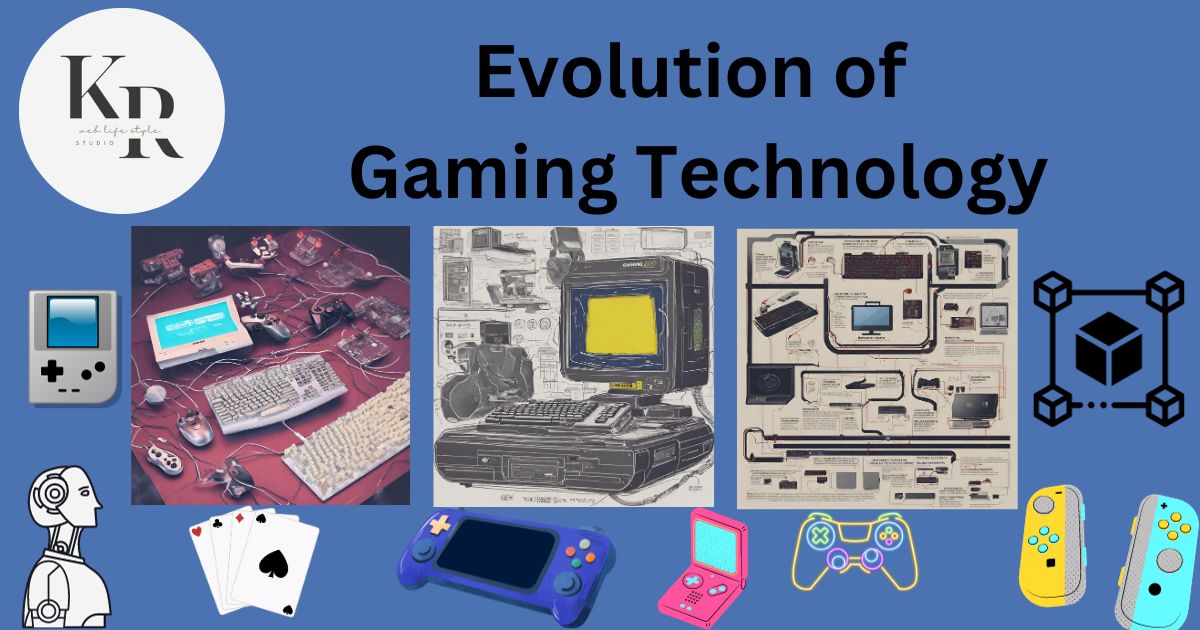The Evolution of Gaming Technology: From Graphics to Cloud Gaming
The world of gaming has undergone a systematic transformation and paralleling the rapid advancement of technology. From the start of arcade games to the cloud gaming experience we play today, gaming technology’s evaluation has been nothing short of amazing. In this article, we explain the transformation of gaming technology.
Discover the transformation of gaming technology, from eye-catching graphics to the revolutionary concept of cloud gaming.

The Rise of Arcade Games
The roots of gaming technology’s evolution trace back to the 1970s, a period indicated by the ascent of arcade games. These coin-operated marvels introduced players to a smorgasbord of attracting experiences, ranging from classics like Pong and Space Invaders to intricate gems like Pac-Man and Donkey Kong. Arcade games swiftly captivated audiences due to their addictive gameplay and communal allure, where players gathered around the glowing screens, vying for supremacy on the high-score leaderboard.
The Emergence of Home Consoles
The early 1980s marked a pivotal juncture in the realm of gaming, as it witnessed the emergence of home gaming consoles. Revolutionary breakthroughs, exemplified by the Atari 2600 and the Nintendo Entertainment System (NES), ushered the enchantment of arcade gaming from bustling gaming arcades into the cozy confines of households worldwide. This transformative paradigm shift amounted to nothing less than a gaming technology renaissance, bestowing accessibility to the gaming world upon the masses and thereby extending a cordial invitation to the embrace of the mainstream.
Transition to 3D Graphics
One of the most monumental leaps in gaming technology materialized during the migration from 2D to 3D graphics. In the mid-1990s, consoles like the Sony PlayStation and the Nintendo 64 ushered in immersive 3D realms that breathed life into games as never before. This quantum leap in graphics technology unfurled novel horizons for game developers, empowering them to craft more verisimilar and visually resplendent virtual worlds.
Introduction of Mobile Gaming
With the advent of smartphones, gaming technology catapulted forward with the introduction of mobile gaming. The ascendancy of mobile app stores provided a fertile ground for developers to cultivate games tailored explicitly for handheld devices. Titles such as Angry Birds and Candy Crush Saga soared to unprecedented heights, underscoring the boundless potential of gaming on the go. Mobile gaming remains in a perpetual state of evolution, perpetually pushing the envelope of what can be achieved on a diminutive screen.
The Birth of Online Multiplayer
The advent of online multiplayer gaming marked a tectonic shift in how individuals engaged with games. The proliferation of high-speed internet connections enabled players to connect with compatriots from across the globe, competing or cooperating in virtual realms. Titles like World of Warcraft and Call of Duty catalyzed this revolution, reshaping the gaming landscape by nurturing expansive online communities and heralding a new epoch of social gaming.
The Impact of Virtual Reality
Virtual Reality (VR), a long-standing aspiration of gamers, finally materialized as a reality, courtesy of recent technological strides. VR headsets such as the Oculus Rift and the HTC Vive immerse users in alternate dimensions, transporting them to virtual realms. The reverberations of VR in gaming have been profound, granting players the sensation of genuinely inhabiting the game. As this technology continues to mature, prospects for even more immersive and true-to-life virtual experiences loom large.
The Advent of Motion Controls
Motion controls introduced a fresh layer of interactivity to gaming, enabling players to physically engage with the game world. The Nintendo Wii, unveiled in 2006, spearheaded motion controls with its innovative Wii Remote. Players could wield the remote like a tennis racket, bowl as if they stood in a real alley, and partake in countless other activities. Motion controls delivered a more instinctive and immersive gaming experience, appealing to a diverse demographic.
The Revolution of eSports
eSports, the realm of competitive gaming, has witnessed meteoric growth, evolving into a global phenomenon. Professional gamers and teams vie for substantial prize pools and the adulation of millions in games like League of Legends, Counter-Strike: Global Offensive, and Dota 2. The surge of eSports has transmogrified gaming into a legitimate competitive sport, with live tournaments packing arenas and millions tuning in online to watch their beloved players vie for glory.
The Integration of Augmented Reality
Augmented Reality (AR) melds the real world with digital overlays, spawning interactive experiences that blend virtual content with tangible reality. The 2016 debut of Pokémon Go thrust AR gaming into the limelight. Players embarked on quests to locate virtual Pokémon superimposed onto real-world locales via their smartphones. The integration of AR technology in gaming portends an uncharted realm, amalgamating the virtual and corporeal domains in hitherto unimagined ways.
The Rise of Open World Games
Open-world games, defined by expansive and immersive realms, have surged in popularity of late. Games like Grand Theft Auto V, The Witcher 3: Wild Hunt, and The Legend of Zelda: Breath of the Wild have set new benchmarks for open-world exploration and narrative depth. Gaming technology’s progression has empowered the crafting of sprawling virtual domains, bestowing players with the liberty to explore, undertake quests, and interact with a dynamic and vibrant game cosmos.
The Evolution of Game Engines
Game engines play a pivotal role in game development, furnishing the bedrock for graphics rendering, physics simulations, and other pivotal game mechanics. Over time, game engines have undergone remarkable evolution, evolving into more robust and versatile tools. Engines like Unity and Unreal Engine have ascended as industry touchstones, empowering developers to craft visually resplendent and technically sophisticated games that span multiple platforms.
The Role of Artificial Intelligence in Gaming
Artificial Intelligence (AI) has become an indispensable component of gaming technology, enhancing the player experience on multiple fronts. AI-driven non-playable characters (NPCs) now exhibit more lifelike behaviors, adapt to player choices, and offer engaging challenges. AI underpins game features such as procedural generation, dynamic difficulty adjustments, and intelligent enemy behavior. As AI marches forward, games are poised to become even more immersive and intelligent.
The Influence of Streaming Platforms
The ascent of streaming platforms like Twitch and YouTube Gaming has revolutionized how gamers engage with content. These platforms empower players to live stream their gameplay, share their adventures, and cultivate communities of like-minded enthusiasts. Streaming has not only opened new avenues for content creators but has also emerged as a crucial marketing conduit for game developers, enabling them to showcase their creations to a global audience.
The Introduction of Cloud Gaming
Cloud gaming represents the latest frontier in gaming technology, promising to reshape how games are experienced. Instead of relying on potent hardware, cloud gaming allows players to stream games directly to their devices. Services such as Google Stadia and Microsoft xCloud grant access to extensive game libraries, obviating the need for high-end gaming consoles or PCs. As internet speeds advance, the democratization of cloud gaming looms on the horizon.
The Future of Gaming Technology
Gazing into the future, the realm of gaming technology beckons with tantalizing possibilities. With strides in virtual reality, augmented reality, artificial intelligence, and cloud gaming, the demarcation between the actual and virtual realms will continue to blur. Anticipate more immersive encounters, more lifelike visuals, and the seamless fusion of gaming into our quotidian existence.
In summation, the odyssey of gaming technology, from its modest inception in arcades to the cutting-edge cloud gaming extravaganzas we enjoy today, is nothing short of spellbinding. Each milestone in gaming technology’s evolution has stretched the boundaries of possibility, endowing gamers with increasingly immersive, interactive, and captivating experiences. As technology advances unabated, we can only envision a future where gaming transcends its current stature, forging new connections and birthing indelible memories.
To read more about Gaming Technology visit
To learn more about Technology news Click Here






